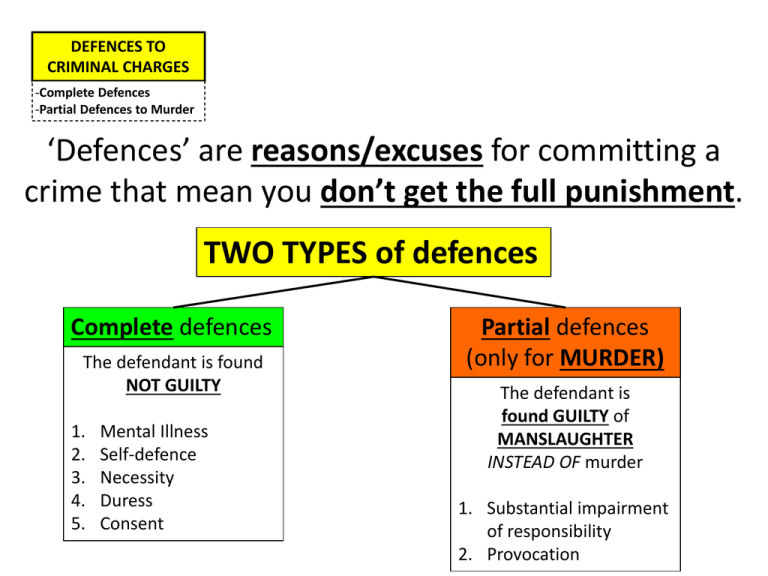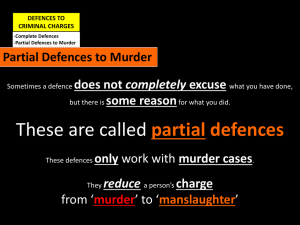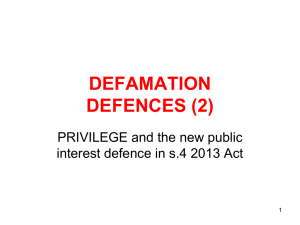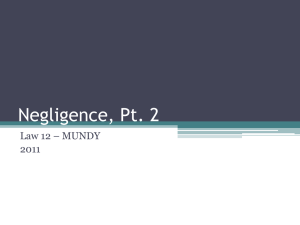
DEFENCES TO
CRIMINAL CHARGES
-Complete Defences
-Partial Defences to Murder
‘Defences’ are reasons/excuses for committing a
crime that mean you don’t get the full punishment.
TWO TYPES of defences
Complete defences
The defendant is found
NOT GUILTY
1.
2.
3.
4.
5.
Mental Illness
Self-defence
Necessity
Duress
Consent
Partial defences
(only for MURDER)
The defendant is
found GUILTY of
MANSLAUGHTER
INSTEAD OF murder
1. Substantial impairment
of responsibility
2. Provocation
DEFENCES TO
CRIMINAL CHARGES
-Complete Defences
-Partial Defences to Murder
Using defences to “get out of” being fully
punished for a crime is very controversial.
They are good for
the defendant…
…but victims and society
aren’t always happy
DEFENCES TO
CRIMINAL CHARGES
-Complete Defences
-Partial Defences to Murder
So we need to DECIDE whether they’re really
achieving justice for defendants, victims and society
Syllabus ‘LEARN TO’:
Assess the use of defences to criminal charges in achieving justice
DEFENCES TO
CRIMINAL CHARGES
-Complete Defences
-Partial Defences to Murder
Assess the use of defences to criminal charges in achieving justice
One GENERAL problem that victims groups and the DPP has had in the past is that
defendants bring up defences as a SURPRISE, which makes it difficult for the DPP to
argue against it.
So, the government passed a law to make it compulsory for defences to be ‘disclosed’
(brought up) BEFORE the trial (Criminal Procedure Amendment (Mandatory Pre-trial
Defence Disclosure) Act 2013).
THIS IS GOOD FOR:
- The Prosecution (DPP)
- Victims
- Society
THIS IS BAD FOR:
- Defendants
DEFENCES TO
CRIMINAL CHARGES
-Complete Defences
-Partial Defences to Murder
Complete Defences: Mental Illness
AKA: “Insanity”
The basics of this defence are:
1. That the person must have a mental illness;
2. That mental illness prevented them from
knowing that what they were doing was
wrong;
3. If the defence works, they are found ‘not
guilty’ by reason of mental illness (but
usually have to go to a psychiatric
institution).
DEFENCES TO
CRIMINAL CHARGES
-Complete Defences
-Partial Defences to Murder
Complete Defences: Mental Illness
WHY ‘NOT GUILTY’???
BECAUSE THERE’S NO MENS REA HERE!
The defendant could not have intended to
commit the crime because they were unable to
understand that what they were doing was
wrong.
DEFENCES TO
CRIMINAL CHARGES
-Complete Defences
-Partial Defences to Murder
Complete Defences: Mental Illness
M’Naghten’s Case (1843)
This paranoid schizophrenic guy (called M’Naghten…
don’t question his name, just memorise it) tried to
murder the Prime Minister of England because he
thought the PM’s Party was out to kill him.
He tried to shoot the PM, but missed and killed
someone else instead!
M’Naghten was found not guilty because they
realised that he was unable to know that what he
was doing was wrong (as far as he was concerned, he
was really in danger!).
DEFENCES TO
CRIMINAL CHARGES
-Complete Defences
-Partial Defences to Murder
Complete Defences: Mental Illness
Assess the use of defences to criminal charges in achieving justice
Movies (and
newspapers like the
Daily Telegraph) give
society the idea that
the Mental Illness
defence is:
1. Used too much
2. An easy way out
DEFENCES TO
CRIMINAL CHARGES
-Complete Defences
-Partial Defences to Murder
Complete Defences: Mental Illness
Assess the use of defences to criminal charges in achieving justice
BUT, the NSW Law Reform Commission report
on Mental Illness (2012) and found two things:
1.
2.
The use of this defence is a lot MORE RARE than
people think
An ‘insanity’ plea is not an easy way out. You still
might end up being locked up FOR LIFE.
DEFENCES TO
CRIMINAL CHARGES
-Complete Defences
-Partial Defences to Murder
Complete Defences: Mental Illness
Assess the use of defences to criminal charges in achieving justice
BUT, the NSW Law Reform Commission report
on Mental Illness (2012) and found two things:
1. The use of this defence is a lot MORE RARE than people think
In Local Courts:
Only 1.4% of people end up getting found not guilty under section 32 or 33 of the Mental
Health (Forensic Provisions) Act, but are usually released to the care of a responsible
person (like a family member) or have to go to a ‘facility’ to be treated for their condition.
In the District Courts and Supreme Court:
There are usually only about 40 cases a year where the defendant even tries to use the
Mental Illness defence under section 12 Mental Health (Forensic Provisions) Act of the
and only about 24 actually work.
DEFENCES TO
CRIMINAL CHARGES
-Complete Defences
-Partial Defences to Murder
Complete Defences: Mental Illness
Assess the use of defences to criminal charges in achieving justice
BUT, the NSW Law Reform Commission report
on Mental Illness (2012) and found two things:
2. An ‘insanity’ plea is not an easy way out. You still might end up being
locked up for life.
Even though the defendant is found not guilty, they DON’T JUST GO STRAIGHT HOME.
The court usually orders that they be detained (“kept”) in a mental health facility, OR EVEN A
PRISON, for an ‘indeterminate’ time (there’s NO MAXIMUM TIME – IT COULD BE FOR LIFE!).
There is a Mental Health Review Tribunal (“MHRT”) that assesses the person once they’re
found not guilty, then the person is ‘detained’, usually for treatment of their disease, then the
MHRT checks regularly to see if it is safe to let them leave.
DEFENCES TO
CRIMINAL CHARGES
-Complete Defences
-Partial Defences to Murder
Complete Defences: Self-Defence
This is when the defendant did what he thought was
needed to defend himself, or someone else, from a
threat.
R v Katarzynski (2002)
(KAT-AR-ZIN-SKI)
DEFENCES TO
CRIMINAL CHARGES
-Complete Defences
-Partial Defences to Murder
Complete Defences: Self-Defence
For ‘self-defence’ to be accepted:
1. The amount of force the defendant used has to be ‘proportionate’
to the threat.
e.g. You can’t stab someone if they are about to punch you (McInnes)
2. The threat doesn’t have to be REAL. The defendant just has to be
defending himself from WHAT HE THINKS is the threat (the
‘perceived threat’).
e.g. If someone threatened him with a gun, but he didn’t know it was
fake, he can still defend himself.
DEFENCES TO
CRIMINAL CHARGES
-Complete Defences
-Partial Defences to Murder
Complete Defences: Necessity
This can be used when the consequences of NOT
committing the crime would have been WORSE than
the consequences OF committing the crime.
DEFENCES TO
CRIMINAL CHARGES
Complete Defences: Necessity
This defence DIDN’T WORK in:
-Complete Defences
-Partial Defences to Murder
Dudley and Stephens v R (1884)
These guys were stranded at sea for 20 days.
They thought they’d starve, so they killed a
boy and ate him. They didn’t even enjoy the
meal…
The strange thing about this case is that the
judge ruled that the defence of necessity still
couldn’t be used here. Apparently the men
COULD still have been rescued, so it wasn’t yet
necessary to commit this crime.
DEFENCES TO
CRIMINAL CHARGES
-Complete Defences
-Partial Defences to Murder
Complete Defences: Necessity
This defence DID WORK in:
R v White (1987).
Mr White was caught speeding and got fined,
but appealed the fine because he said he was
rushing his son to hospital (the boy was
apparently having an asthma attack).
The judge said his son dying would have been
WORSE THAN the consequences of speeding.
Therefore, there was a necessity for the crime
to be committed.
DEFENCES TO
CRIMINAL CHARGES
-Complete Defences
-Partial Defences to Murder
Complete Defences: Duress
If you do something under duress, you are
doing it because someone is threatening
you.
As a defence, you have to prove that you
genuinely believed that your life or
someone else’s life was in danger if you
did NOT commit the crime.
R v Williamson (1972)
A guy (Williamson) disposed of a body for
someone else while under the threat of
death (i.e. “Bury this body or I’ll kill you”).
DEFENCES TO
CRIMINAL CHARGES
-Complete Defences
-Partial Defences to Murder
Complete Defences: Consent
If you ‘consent’ to something, ALLOW it to happen.
Some things are only crimes if you DON’T consent to them happening.
For example, sex between adults is legal. If one of them doesn’t consent, then it is against
the law.
So, you can use the fact that the victim consented to what you did as a
defence to a crime.
For example, if you are walking down the street, you do not consent to some guy running up
and tackling you. If someone does that, they are assaulting you.
However, if you go onto a football field to play a game of tackle football, you do consent to
getting tackled. So, if one of the other players ended up in court because he tackled you,
you could use consent as a defence.
DEFENCES TO
CRIMINAL CHARGES
-Complete Defences
-Partial Defences to Murder
Complete Defences: Consent
Assess the use of defences to criminal charges in achieving justice
You CAN’T use consent as a defence to MURDER/MANSLAUGHTER.
This is why euthanasia is illegal – you can’t consent to having someone
take your life (in NSW).
This has been a very controversial area of the law.
Why can you kill yourself, but if you’re disabled and you need help to do it, that person is a
criminal?
Euthanasia laws can be very difficult to make though.
How do you stop someone from lying about whether the person really consented?
How do you stop people from being pressured into giving their consent? Like an old lady?











